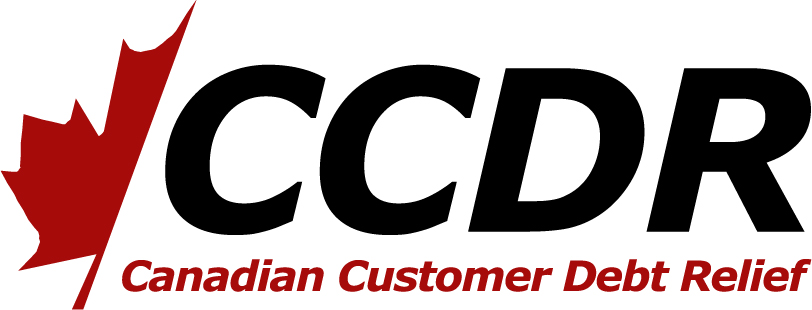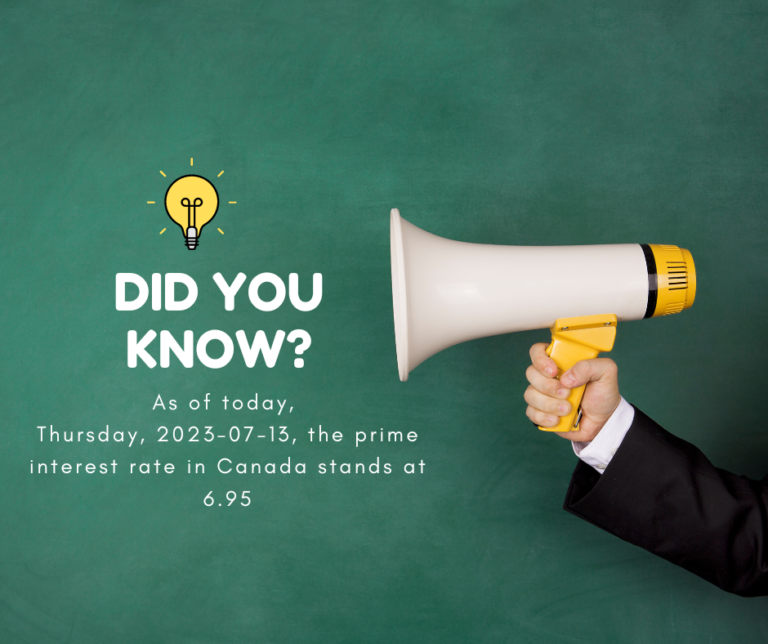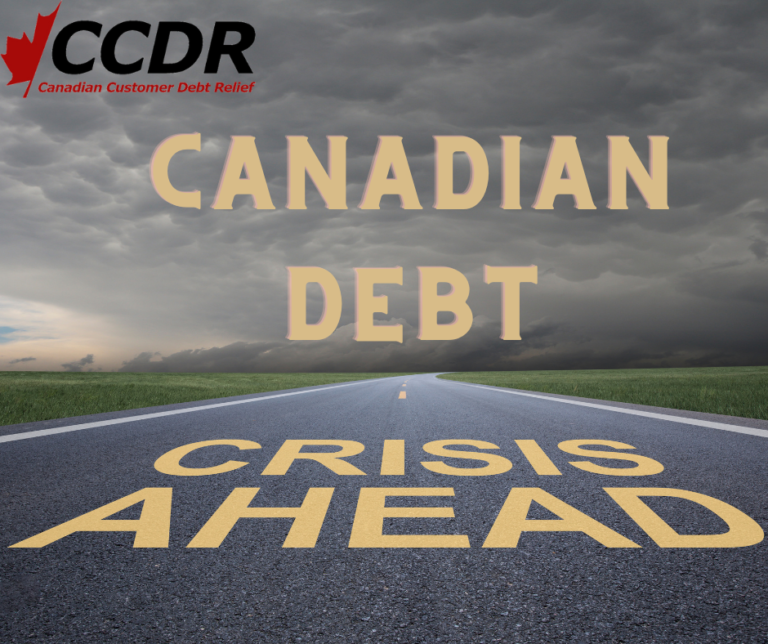Debt Management
Exploring Canada’s Prime Interest Rate: A Key Indicator of Economic Stability
The prime interest rate is a crucial benchmark that significantly shapes Canada’s financial landscape. As a critical monetary policy tool, it influences borrowing costs, impacts the housing market, and reflects the overall state of the economy. In this article, we will delve into the prime interest rate in Canada, its importance, and how it affects various aspects of our daily lives.
Understanding the Prime Interest Rate: The prime interest rate represents the interest rate banks charge their most creditworthy customers for loans. It serves as the foundation for determining borrowing costs across various financial products, including mortgages, personal loans, business loans, and lines of credit. The Bank of Canada sets the target for the prime rate, which influences lending rates across the country.
Current Prime Interest Rate in Canada: As of today, Thursday, 2023-07-13, the prime interest rate in Canada stands at 6.95%. It is important to note that the prime rate can fluctuate over time as economic conditions change. Financial institutions may adjust their prime rates accordingly, reflecting factors such as inflation, economic growth, and the monetary policy decisions of the central bank.
Impact on Borrowers: The prime interest rate directly affects borrowers in Canada. When the prime rate increases, borrowing costs rise, making it more expensive to take out loans or carry balances on lines of credit. Conversely, decreasing the prime rate can lead to lower borrowing costs, providing potential savings for borrowers. Homeowners with variable-rate mortgages are particularly impacted, as their interest rates can change when the prime rate fluctuates.
Influence on the Housing Market: The prime interest rate significantly influences the housing market. When the prime rate is high, mortgage rates tend to increase, making it more challenging for prospective homebuyers to afford homeownership. Conversely, a lower prime rate can stimulate the housing market by making mortgages more affordable and potentially increasing property demand. It is essential for individuals considering homeownership to monitor changes in the prime rate to make informed decisions.
Economic Indicator: The prime interest rate is also a crucial economic indicator. It reflects the central bank’s assessment of the country’s economic conditions and efforts to manage inflation and stimulate economic growth. When the prime rate is adjusted, it can signal the central bank’s stance on monetary policy and its views on the economy’s overall health.
The prime interest rate is a vital element of Canada’s financial system, influencing borrowing costs and reflecting the state of the economy. As of today, the prime rate in Canada stands at 6.95%. Understanding the prime rate’s impact on borrowing costs, the housing market, and its role as an economic indicator helps individuals make informed financial decisions. Keeping a close eye on changes in the prime rate can help borrowers and potential homeowners navigate the ever-changing financial landscape.
Debt Doldrums in Canada and How Canadian Customer Debt Relief can help
Debt Doldrums in Canada and How Canadian Customer Debt Relief can help
Canada is currently facing a significant challenge when it comes to consumer debt. Many Canadians find themselves caught in a cycle of debt, struggling to make ends meet and overcome their financial burdens. This article aims to shed light on the state of debt in Canada and highlight how Canadian Customer Debt Relief can provide much-needed assistance to those in need.
The State of Debt in Canada
In recent years, consumer debt levels in Canada have been steadily rising. According to the Bank of Canada, household debt reached a record high in 2022, surpassing $2.4 trillion. This staggering figure indicates that many Canadians live beyond their means and rely heavily on credit to finance their lifestyles.
Several factors contribute to the increasing debt burden faced by Canadians. One of the main culprits is the easy availability of credit, with credit cards and lines of credit readily accessible to consumers. Low-interest rates and enticing promotional offers often lure individuals into taking on more debt than they can handle.
The Impact of Debt on Canadian Consumers
The burden of debt has far-reaching consequences for Canadian consumers. Financial stress from overwhelming debt can affect individuals’ mental health and well-being. The constant worry about making monthly payments and the fear of falling behind can lead to anxiety, depression, and sleep disturbances.
Moreover, excessive debt limits consumers’ purchasing power and financial flexibility. High monthly debt payments eat into disposable income, leaving individuals with less money for essential expenses, savings, and investments. This can hinder their ability to achieve important life goals, such as homeownership or funding their children’s education.
Canadian Customer Debt Relief: How It Works
Canadian Customer Debt Relief is a reputable debt relief program designed to assist Canadians in overcoming their debt challenges. The program follows a structured process to provide effective and personalized debt relief solutions.
The first step in Canadian Customer Debt Relief is thoroughly assessing the individual’s financial situation. This involves evaluating their income, expenses, assets, and liabilities to understand their overall financial health comprehensively.
Based on this assessment, Canadian Customer Debt Relief develops a customized debt relief plan tailored to the individual’s needs and goals. This plan may involve a combination of debt-help strategies.
Canadian Customer Debt Relief provides ongoing support and guidance throughout the debt relief journey. Their team of financial experts offers advice on budgeting, money management, and improving credit scores. They aim to empower individuals with the necessary tools and knowledge to regain control of their finances and maintain a debt-free future.
Benefits of Canadian Customer Debt Relief
Engaging in a Canadian Customer Debt Relief program offers several benefits for individuals struggling with debt. Some of the key advantages include:
- Lower interest rates: Canadian Customer Debt Relief can secure 0% interest rates, reducing the overall cost of debt repayment.
- Reduced monthly payments: Through our debt help program, individuals can lower their monthly payments, making them more affordable and manageable within their budget.
- Consolidated debt management: Combining multiple debts into a single debt simplifies repayment. Instead of juggling various due dates and payment amounts, individuals only need to focus on a single monthly payment.
- Improved credit score: Completing a Canadian Customer Debt Relief program can improve an individual’s credit score. By consistently making timely payments and reducing debt, individuals demonstrate responsible financial behavior to credit agencies.
Conclusion
The escalating debt levels in Canada have put many individuals in challenging financial situations. However, Canadian Customer Debt Relief offers hope for those struggling with overwhelming debt. By providing personalized debt relief solutions, Canadian Customer Debt Relief aims to alleviate financial burdens and help individuals regain control of their finances.
Canadian Customer Debt Relief can tailor a customized plan that addresses their needs by assessing the individual’s financial situation. This personalized approach ensures that the debt relief strategy aligns with the individual’s goals and financial capabilities.
One of the primary advantages of Canadian Customer Debt Relief is 0% interest rates. The program secures a 0% interest rate, minimizing the overall cost of debt repayment. This can significantly ease the financial strain on individuals and expedite the path to debt freedom.
Additionally, Canadian Customer Debt Relief aims to reduce monthly payments, making them more manageable within the individual’s budget. By consolidating multiple debts into a single manageable payment, individuals can experience immediate relief and regain control over their financial obligations.
Consolidating debts into a single payment simplifies repayment and helps individuals stay organized and on top of their financial commitments. Instead of dealing with multiple due dates and varying payment amounts, individuals can focus on a single monthly payment, streamlining their debt management.
Another notable benefit of engaging in Canadian Customer Debt Relief is the potential for improving one’s credit score. By completing the debt relief program and consistently making timely payments, individuals can demonstrate responsible financial behavior to credit agencies. Over time, this can lead to an improved credit score, opening doors to better economic opportunities in the future.
In conclusion, the debt doldrums in Canada have created significant financial challenges for many individuals. However, Canadian Customer Debt Relief offers a beacon of hope, providing tailored debt relief solutions to help Canadians overcome their debt burdens.
FAQs
1. How long does completing a Canadian Customer Debt Relief program take? The duration of a Canadian Customer Debt Relief program varies depending on the individual’s financial situation and the selected debt relief strategies. It can take several months to a few years to complete the program successfully.
2. Will participating in a debt relief program affect my credit score? Engaging in a debt relief program may initially slightly impact your credit score. However, as you consistently make payments and reduce your debt through the program, your credit score has the potential to improve over time.
3. Can I still use credit cards while enrolled in a Canadian Customer Debt Relief program? Refraining from using credit cards while enrolled in a debt relief program is generally advisable. Limiting new credit usage allows you to repay your debts and improve your financial situation.
4. Will I be debt-free after completing a Canadian Customer Debt Relief program? Completing The Canadian Customer Debt Relief program will provide a pathway to becoming debt-free. However, it is essential to maintain responsible financial habits and avoid accumulating new debt after the program’s completion.
5. How do I get started with Canadian Customer Debt Relief? To get started with Canadian Customer Debt Relief, visit their website and provide the necessary information for a consultation. Their team will assess your financial situation and guide you through finding the most suitable debt relief solution for your needs.
In conclusion, Canadian Customer Debt Relief offers a comprehensive approach to tackling debt in Canada. Individuals can find relief from financial burdens by accessing personalized debt relief solutions and working towards a debt-free future. Remember, there is hope for a brighter financial future, and Canadian Customer Debt Relief is here to assist you on your journey to financial freedom.
10 Tips for Maintaining a Healthy Budget at Home
Maintaining a healthy budget at home has become more critical today, where everything seems to be getting expensive daily. As a result, we have to be more mindful of our finances and keep our expenses in check. This article will provide ten practical tips for maintaining a healthy budget at home.
Create a budget plan
Creating a budget plan is the first step in maintaining a healthy home budget. This will help you keep track of your expenses and identify areas where you can cut down your costs. Next, list your monthly income and expenses, including your bills, groceries, and other miscellaneous costs.
Cut down on unnecessary expenses
Once you have created your budget plan, it’s time to cut down on unnecessary expenses. This includes dining out, buying clothes you don’t need, and subscription services you rarely use. Instead, focus on spending on essential items and prioritize your expenses accordingly.
Plan your meals in advance
Planning your meals can help you save significant money. For example, list the groceries you need for the week and avoid impulse purchases. Additionally, you can opt for budget-friendly meals and make use of leftovers.
Avoid unnecessary debt
Avoid taking on unnecessary debt and always pay your bills on time. This will help you avoid late fees and penalties, which can add up to a significant amount over time. In addition, if you have existing debt, pay it off as soon as possible to avoid accruing additional interest charges.
Reduce energy consumption
Reducing your energy consumption can help you save significant money on your utility bills. You can do this by turning off lights and appliances when not in use, using energy-efficient light bulbs, and reducing water usage.
Consider refinancing your mortgage
If you have a mortgage, consider refinancing it to a lower interest rate. This can help you save on monthly mortgage payments and free up extra cash for other expenses.
Find ways to earn extra income
Finding ways to earn extra income can also help you maintain a healthy budget at home. For example, you can take on a part-time or freelancing job, sell unwanted items online, or offer your skills and services to others.
Use coupons and discount codes
Using coupons and discount codes can help you save money on your purchases. Look for online deals and coupon codes before purchasing, and take advantage of sales and promotional offers.
Invest in home maintenance
Investing in home maintenance can help you avoid costly repairs and replacements in the future. Regularly cleaning and maintaining your home appliances and systems can also help you save money on your utility bills.
Set financial goals
Finally, setting financial goals can help you stay motivated and focused on maintaining a healthy budget at home. Whether saving for a vacation or paying off debt, having a clear plan can help you prioritize your expenses and make smart financial decisions.
In conclusion, maintaining a healthy budget at home requires discipline, planning, and intelligent financial decisions. By following these tips, you can reduce your expenses, avoid unnecessary debt, and save money for the future.
Consumer Debt Crisis in Canada: Understanding the Issue and Finding Solutions
As the cost of living continues to rise in Canada, more and more consumers are finding themselves in financial trouble. The Consumer Debt Crisis in Canada is a growing problem that affects millions of people every year. In this article, we will explore the root causes of this crisis, the impact it has on Canadians, and what can be done to prevent it.
What is Consumer Debt?
Consumer debt is the total amount of money that a person owes on their credit cards, loans, and other forms of borrowing. This type of debt is also known as household debt because it is often used to finance the purchase of everyday goods and services. While it is normal for Canadians to have some level of debt, it becomes a problem when it becomes unmanageable.
The State of Consumer Debt in Canada
According to a report by the Bank of Canada, the level of household debt in Canada has risen steadily over the past decade. In fact, as of 2020, Canadians owe a total of $2.2 trillion in consumer debt. This figure includes credit card debt, auto loans, and other forms of borrowing. With such a large amount of debt, it is not surprising that many Canadians are struggling to make ends meet.
Causes of Consumer Debt in Canada
There are several reasons why consumer debt has become such a pressing issue in Canada. One of the main reasons is the high cost of living. As the cost of housing, food, and other necessities continues to rise, many Canadians are finding it difficult to keep up with their expenses. Additionally, low wages and job instability have made it difficult for many people to maintain a steady income.
Another contributing factor to consumer debt in Canada is the easy availability of credit. Banks and other financial institutions are quick to offer credit to consumers, often without considering their ability to repay the debt. As a result, many people end up with high levels of debt that they are unable to repay.
The Impact of Consumer Debt on Canadians
Consumer debt has a significant impact on Canadians’ financial well-being. High levels of debt can lead to stress, anxiety, and depression. It can also make it difficult for people to make ends meet, leading to financial instability and even bankruptcy.
Consumer debt also has a broader impact on the Canadian economy. When consumers are unable to pay their debts, it can lead to a decrease in spending and a slowdown in economic growth. This, in turn, can lead to job losses and a decrease in overall economic activity.
Solutions to the Consumer Debt Crisis
To address the issue of consumer debt in Canada, there are several solutions that can be implemented. One solution is to increase financial literacy among Canadians. By teaching people about personal finance and money management, they can better understand how to manage their debt and avoid financial trouble.
Another solution is to regulate the lending practices of banks and other financial institutions. By requiring lenders to consider a borrower’s ability to repay a debt before offering credit, it can help prevent consumers from taking on more debt than they can handle.
Finally, providing support to Canadians who are struggling with debt can also help. This can include debt counseling, financial planning services, and other forms of assistance.
Conclusion
The Consumer Debt Crisis in Canada is a complex issue that affects millions of people every year. Understanding the root causes of the problem and finding solutions to address it is essential for improving the financial well-being of Canadians. By increasing financial literacy, regulating lending practices, and providing support to those in need, we can by increasing financial literacy, regulating lending practices, and providing support to those in need, we can help prevent the cycle of debt from continuing. It is important for Canadians to take a proactive approach to manage their debt and seek help if they are struggling. With the right strategies and support in place, it is possible to overcome the Consumer Debt Crisis in Canada.
FAQs:
Q1. How can I tell if I have too much debt? A1. If your debt is taking up a significant portion of your income and you are struggling to make ends meet, you may have too much debt. It is important to assess your debt-to-income ratio and create a plan to manage your debt.
Q2. What is a debt-to-income ratio? A2. A debt-to-income ratio is a measure of how much debt you have compared to your income. It is calculated by dividing your total monthly debt payments by your gross monthly income. A high debt-to-income ratio can indicate that you are taking on too much debt.
Q3. What is a credit score? A3. A credit score is a numerical representation of your creditworthiness. It is calculated based on your credit history, including your payment history, the amount of debt you have, and the length of your credit history.
Q4. How can I improve my credit score? A4. You can improve your credit score by paying your bills on time, keeping your credit card balances low, and avoiding opening too many new accounts at once. It is also important to review your credit report regularly to ensure that there are no errors or fraudulent accounts.
Q5. Can debt consolidation help me manage my debt? A5. Debt consolidation can be a useful tool for managing debt, as it allows you to combine multiple debts into one monthly payment. However, it is important to consider the costs and fees associated with debt consolidation before making a decision. It is also important to address the underlying issues that led to the accumulation of debt in the first place.




